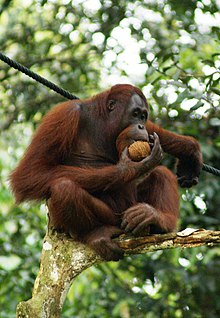Pongo
| Pongo | |
|---|---|
 | |
| Sailkapen zientifikoa | |
| Klasea | Mammalia |
| Ordena | Primates |
| Familia | Hominidae |
| Subfamilia | Ponginae |
| Generoa | Pongo Lacépède, 1799
|
| Azpibanaketa | |
| Banaketa mapa | |
 | |
| Datu orokorrak | |
| Elikadura iturri nagusia | fruitua |
Pongo, orangutanak edo orang-utanak primate genero bat da. Gorila, Pan eta gizakiekin batera Hominidae osatzen dute.
Etimologia
[aldatu | aldatu iturburu kodea]Izena malaysieratik dator,[1] orang 'pertsona' eta hutan 'baso, oihan' hitzetatik, hots, 'basoko pertsona' esan nahi du.[1][2][3]
Espezieak
[aldatu | aldatu iturburu kodea]Hiru orangutan espezie ezagutzen dira.[4]
- Borneoko orangutana (Pongo pygmaeus) – Linnaeus, 1760
- Pongo pygmaeus pygmaeus
- Pongo pygmaeus morio
- Pongo pygmaeus wurmbii
- Sumatrako orangutana (Pongo abelii) – Lesson, 1827
- Tapanuliko orangutana (Pongo tapanuliensis) – Nurcahyo, Meijaard, Nowak, Fredriksson & Groves, 2017
| Wikimedia Commonsen badira fitxategi gehiago, gai hau dutenak: Pongo |
Anatomia
[aldatu | aldatu iturburu kodea]Orangutanek beso luzeak dituzte eta ile gorria edo arrea. Bertikalki 2 metroraino luze izaten dira, baina gehienetan, 1,75 metrora iristen dira. Besoak zabalik dituztela, 3 metroko zabalera dute. Arrek 120 kiloko pisua izaten dute.[5][6]
Ekologia
[aldatu | aldatu iturburu kodea]Malaisia eta Indonesiako oihan tropikaletako Dipterocarpaceae familiako zuhaitzetan eta baso sekundarioetan bizi dira.[7][8][9]
Erreferentziak
[aldatu | aldatu iturburu kodea]- ↑ a b Sastrawan, Wayan Jarrah. (2020-11-06). «The Word ‘Orangutan’: Old Malay Origin or European Concoction?» Bijdragen tot de taal-, land- en volkenkunde / Journal of the Humanities and Social Sciences of Southeast Asia 176 (4): 532–541. doi:. ISSN 0006-2294. (Noiz kontsultatua: 2022-09-23).
- ↑ (Ingelesez) «Home : Oxford English Dictionary» www.oed.com (Noiz kontsultatua: 2022-09-23).
- ↑ (Ingelesez) «orangutan | Etymology, origin and meaning of orangutan by etymonline» www.etymonline.com (Noiz kontsultatua: 2022-09-23).
- ↑ Mammal species of the world : a taxonomic and geographic reference. (3rd ed. argitaraldia) Johns Hopkins University Press 2005 ISBN 0-8018-8221-4. PMC 57557352. (Noiz kontsultatua: 2022-09-23).
- ↑ Payne, Junaidi. (2008). Orangutans : behavior, ecology, and conservation. MIT Press ISBN 978-0-262-16253-1. PMC 166290656. (Noiz kontsultatua: 2022-09-23).
- ↑ Groves, Colin P.. (1971-01-19). «Pongo pygmaeus» Mammalian Species (4): 1. doi:. (Noiz kontsultatua: 2022-09-23).
- ↑ Rijksen, H. D.. (1999). Our vanishing relative : the status of wild orang-utans at the close of the twentieth century. ISBN 94-010-9020-3. PMC 1058973869. (Noiz kontsultatua: 2022-09-23).
- ↑ The Encyclopedia of mammals. Facts on File 1984 ISBN 0-87196-871-1. PMC 10403800. (Noiz kontsultatua: 2022-09-23).
- ↑ (Ingelesez) Galdikas, Biruté M. F.. (1988-02). «Orangutan diet, range, and activity at Tanjung Puting, Central Borneo» International Journal of Primatology 9 (1): 1–35. doi:. ISSN 0164-0291. (Noiz kontsultatua: 2022-09-23).
Text is available under the CC BY-SA 4.0 license; additional terms may apply.
Images, videos and audio are available under their respective licenses.
